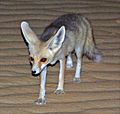Rüppell's fox facts for kids
Quick facts for kids Rüppell's fox |
|
|---|---|
 |
|
| Conservation status | |
| Scientific classification | |
| Kingdom: | |
| Phylum: | |
| Class: | |
| Order: | |
| Family: | |
| Genus: | |
| Species: |
V. rueppellii
|
| Binomial name | |
| Vulpes rueppellii (Schinz, 1825)
|
|
 |
|
| Rüppell's fox range | |
The Rüppell's fox (Vulpes rueppellii) is a cool type of fox. It lives in dry, sandy places across North Africa, the Middle East, and parts of southwestern Asia. This fox is named after a German scientist named Eduard Rüppell. Sometimes people call it the "sand fox," but that can be a bit confusing. Other foxes, like the corsac fox and the Tibetan sand fox, are also called "sand foxes."
Contents
What Does a Rüppell's Fox Look Like?
Rüppell's foxes are small. They are about 66 to 74 centimeters (26 to 29 inches) long, including their tail. Their bushy tail is about 27 to 30 centimeters (11 to 12 inches) long. Male foxes are usually a bit bigger than females. Both sexes weigh around 3.6 kilograms (8 pounds).
Their fur is sandy-colored, with many white hairs mixed in. It's a bit reddish along their back. The fur fades to pure white on their belly and the tip of their tail. Their face has a rusty color on the nose and forehead. They have dark brown patches near their eyes. Their chin and the sides of their face are white. They also have long whiskers, up to 7 centimeters (2.8 inches) long.
Rüppell's foxes have fur on the pads of their feet. This fur helps them walk easily on sand. It also protects their feet from the hot desert ground. Like other desert foxes, they have big ears. These large ears help them cool down in the heat. Young Rüppell's foxes might look a bit like adult fennec foxes. But Rüppell's foxes have much larger ears than red or pale foxes. Also, their fur is much lighter than a red fox's. Pale foxes don't have white tips on their tails like Rüppell's foxes do.
Where Do Rüppell's Foxes Live?
You can find Rüppell's foxes across North Africa. They live south of the Atlas Mountains. Their home stretches from Mauritania and Morocco in the west to Egypt and Djibouti in the east. They also live in the Arabian Peninsula. This includes places like Syria, Palestine, Jordan, Iraq, Iran, Pakistan, and Afghanistan.
These foxes love sandy or rocky deserts. But they can also live in dry grasslands or areas with scattered bushes.
How Do Rüppell's Foxes Live?
Rüppell's foxes usually have one mate for life. They are active during the evening or at night. During the day, they rest in their dens. When it's not breeding season, their dens are small. They can only hold one fox. A fox might change dens every five days or so.
Dens used for breeding are bigger. A male and female fox, along with their babies, live there. These dens sometimes have more than one entrance, but that's not common. Most dens are dug under rocks or trees.
Rüppell's foxes have special scent glands near their tail. They use these glands to greet each other. They also spray predators with a strong smell if they feel threatened. Female foxes use their scent to mark the den where their babies are. They make short barks when they are mating. Other sounds they make include hisses, trills, and sharp whistles. People have seen them wag their tails, just like pet dogs!
These foxes have their own special areas, called territories. They mark these areas with their urine. Unlike red foxes, they don't use their poop to mark territory. A mated pair's territories overlap almost completely. But they are completely separate from other fox pairs. They keep these territories all year. Even outside of breeding season, the male and female might sleep in separate dens. The size of their territory changes depending on the land. In Oman, it can be about 70 square kilometers (27 square miles). Males usually have larger territories than females. They travel far at night to find food, sometimes over 9 kilometers (5.6 miles) in one night.
Rüppell's foxes live in the desert because of bigger foxes like the red fox. Their main natural enemies are large birds. These include the steppe eagle and the eagle-owl.
What Do Rüppell's Foxes Eat?
Rüppell's foxes are omnivores, meaning they eat both plants and animals. Their diet changes a lot based on what food is available. In some places, they mostly eat insects. They especially like beetles and grasshoppers. In other areas, they eat more small mammals, lizards, and birds.
They also eat plants like grasses and desert succulents. They enjoy fruits such as dates. Sometimes, they even look for food in human garbage.
Rüppell's Fox Life Cycle and Reproduction
The female fox gets the breeding den ready. After about 52 to 53 days, she gives birth to her babies, called kits. A litter can have up to six kits, but usually it's two or three. The kits are born blind. They stop drinking their mother's milk when they are 6 to 8 weeks old.
They become independent at about four months old. At this age, they might travel up to 48 kilometers (30 miles) to find their own territory. In the wild, they usually live for about seven years. But in zoos, they have been known to live up to 12 years!
Rüppell's Foxes and People
For the last 100 years, some people have seen Rüppell's foxes as a problem. In Arabia, they sometimes hunt farm animals. This includes chickens, young lambs, and baby goats.
Images for kids
See also
 In Spanish: Zorro de Rüppell para niños
In Spanish: Zorro de Rüppell para niños





